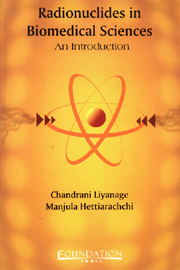Book contents
- Frontmatter
- Contents
- Forewords
- Introduction
- 1 Atomic and Nuclear Structure
- 2 Radiation Detectors
- 3 Units of Radiation Measurements
- 4 Iodine–125
- 5 Radioimmunoassay
- 6 Quality Control in RIA
- 7 Radiolabelled Compounds
- 8 Radiation Safety
- 9 Radiation Protection
- 10 Background Radiation
- 11 Storage
- 12 Contamination
- 13 Radioactive Waste
- References
4 - Iodine–125
Published online by Cambridge University Press: 26 October 2011
- Frontmatter
- Contents
- Forewords
- Introduction
- 1 Atomic and Nuclear Structure
- 2 Radiation Detectors
- 3 Units of Radiation Measurements
- 4 Iodine–125
- 5 Radioimmunoassay
- 6 Quality Control in RIA
- 7 Radiolabelled Compounds
- 8 Radiation Safety
- 9 Radiation Protection
- 10 Background Radiation
- 11 Storage
- 12 Contamination
- 13 Radioactive Waste
- References
Summary
Iodine-125 (125I) has many useful attributes as a general radioisotopic label. It is chemically very reactive and can be incorporated into many types of molecules. It is readily available from several commercial sources with virtually 100% radioisotopic purity, i.e., without any non-radioactive iodine. This means that it is possible to incorporate the maximum number of radioactive atoms into a molecule during the labelling process.
The ease of detection is one of the most useful aspects of radioiodine labels. 125I is detected by placing the sample directly adjacent to a crystal of sodium iodide, containing small amounts of thallium. The gamma rays from the radioisotope are absorbed and the energy is converted to flashes of light. The light photons produced by the crystal are counted by conventional photomultiplier tubes. To increase the efficiency of energy transfer from the isotope to the crystal, a small well is often made in the crystal into which the sample is placed.
The energy from 125I is sufficiently high to give efficient detection but not high enough to cause undue concern with regard to radiation hazards. The literature contains many references to the dangers and hazards of radioisotopic tracers. These references are not only misleading but, in many cases, grossly inaccurate; whilst the handling of mCi amounts of radioiodine during the labelling procedures necessitates care and experience to avoid the hazard of direct ingestion of the volatile radioactive iodine, the use of μCi amounts of label in an assay exposes the laboratory worker to no real hazard.
- Type
- Chapter
- Information
- Radionuclides in Biomedical SciencesAn Introduction, pp. 18 - 32Publisher: Foundation BooksPrint publication year: 2008



